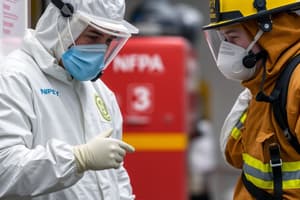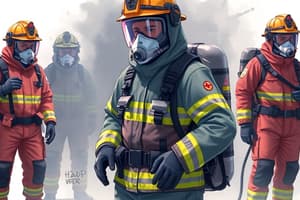Podcast
Questions and Answers
What is the primary goal of pasteurization?
What is the primary goal of pasteurization?
- To kill vegetative pathogens while preserving flavor (correct)
- To remove all viable microbes from surfaces
- To sterilize liquids completely
- To disinfect surfaces without altering their characteristics
Which term describes the process that destroys all viable microbes?
Which term describes the process that destroys all viable microbes?
- Sterilization (correct)
- Disinfection
- Degermation
- Sanitization
What is the mode of action of an autoclave?
What is the mode of action of an autoclave?
- Complete oxidation of cells
- Destruction of all pathogens including spores
- Chemical inhibition of vegetative pathogens
- Denaturation of proteins through moisture and heat (correct)
Which of the following methods is considered a microbistatic approach?
Which of the following methods is considered a microbistatic approach?
Which technique uses hot air to sterilize materials?
Which technique uses hot air to sterilize materials?
What is a key characteristic of disinfectants?
What is a key characteristic of disinfectants?
What temperature and pressure does an autoclave typically use for effective sterilization?
What temperature and pressure does an autoclave typically use for effective sterilization?
Antiseptic agents are primarily designed for which purpose?
Antiseptic agents are primarily designed for which purpose?
Which of the following practices is classified as degermation?
Which of the following practices is classified as degermation?
What is the primary difference between sterilization and disinfection?
What is the primary difference between sterilization and disinfection?
Autoclaving achieves disinfection at 121ºC for 15 minutes.
Autoclaving achieves disinfection at 121ºC for 15 minutes.
Disinfectants are safe to use on inanimate objects only.
Disinfectants are safe to use on inanimate objects only.
Sanitization is a process that removes all viable microbes from surfaces.
Sanitization is a process that removes all viable microbes from surfaces.
Cold temperatures can completely eliminate microbial growth in food.
Cold temperatures can completely eliminate microbial growth in food.
Pasteurization aims to achieve sterilization of liquids.
Pasteurization aims to achieve sterilization of liquids.
Incineration can reach temperatures between 800 to 6,500°C.
Incineration can reach temperatures between 800 to 6,500°C.
Degermation is a cleansing technique that increases the number of microbes on the skin.
Degermation is a cleansing technique that increases the number of microbes on the skin.
Moist heat is less effective than dry heat for sterilization purposes.
Moist heat is less effective than dry heat for sterilization purposes.
Soaps and detergents are considered disinfectants.
Soaps and detergents are considered disinfectants.
The flash method is a widely used technique in pasteurization.
The flash method is a widely used technique in pasteurization.
What is the main function of sanitization in microbial control?
What is the main function of sanitization in microbial control?
What does the process of degermation specifically target?
What does the process of degermation specifically target?
Which statement about pasteurization is correct?
Which statement about pasteurization is correct?
Which method of microbial control uses extremely high temperatures to achieve oxidation of cells?
Which method of microbial control uses extremely high temperatures to achieve oxidation of cells?
What is the effect of cold temperatures on microbial growth?
What is the effect of cold temperatures on microbial growth?
At what temperature does moist heat sterilization typically occur in an autoclave?
At what temperature does moist heat sterilization typically occur in an autoclave?
What differentiates disinfectants from antiseptics?
What differentiates disinfectants from antiseptics?
In which condition is moist heat more effective than dry heat?
In which condition is moist heat more effective than dry heat?
What is the primary function of a disinfectant?
What is the primary function of a disinfectant?
What is the primary technique called that uses soap and detergents to clean surfaces?
What is the primary technique called that uses soap and detergents to clean surfaces?
Match the following microbial control processes with their definitions:
Match the following microbial control processes with their definitions:
Match the following terms with their appropriate examples:
Match the following terms with their appropriate examples:
Match each term with its primary focus:
Match each term with its primary focus:
Match the following terms with their properties:
Match the following terms with their properties:
Match the technique to its correct description:
Match the technique to its correct description:
Match the following microbial control methods with their primary characteristics:
Match the following microbial control methods with their primary characteristics:
Match the following temperatures to their corresponding sterilization or control method:
Match the following temperatures to their corresponding sterilization or control method:
Match the following methods with their modes of action:
Match the following methods with their modes of action:
Match the following microbial control techniques with their appropriate uses:
Match the following microbial control techniques with their appropriate uses:
Match the following statements with their corresponding techniques:
Match the following statements with their corresponding techniques:
Match the following terms with their definitions:
Match the following terms with their definitions:
Match the following methods with their specific goals:
Match the following methods with their specific goals:
Match the following descriptions to the correct processes:
Match the following descriptions to the correct processes:
Flashcards are hidden until you start studying
Study Notes
Decontamination Procedures
- Sterilization: Destroys or removes all viable microbes, including viruses and endospores. This is the highest level of decontamination.
- Disinfection: Kills vegetative pathogens but not bacterial endospores. Generally applied to inanimate objects.
- Sanitization: Removes microbes from inanimate objects through mechanical cleaning. Soaps and detergents are commonly used.
- Degermation: Reduces microbes on the skin, such as surgical hand scrubs or alcohol wipes.
- Antisepsis: Chemical agents applied to the body to destroy or inhibit vegetative pathogens.
Physical Microbial Control Methods
Moist Heat
- Autoclaving: Uses high temperature and steam under pressure to achieve sterilization.
- Denatures proteins.
- Standard conditions: 121°C/ 15 psi/ 15 min
- Pasteurization: Heat applied to liquids to kill infectious and spoilage agents. Achieves disinfection, not sterilization.
- Focus is on killing vegetative pathogens while preserving flavor and nutrients.
- Flash method: 15 seconds at 71.6°C
Dry Heat
- Requires higher temperatures than moist heat.
- Dry Ovens: Use hot air circulating in an enclosed environment.
- Sterilization occurs at 150-180°C.
- Denatures proteins.
- Incineration: Utilizing a flame or electric heating coil to reach extremely high temperatures.
- 800-6,500°C
- Complete oxidation and combustion of cells.
Cold Temperatures
- Microbistatic: Slows microbial growth.
- Used to preserve food and other perishable materials.
- Refrigeration: 0-15°C
- Freezing: While deadly for some microbes, primarily slows growth.
Microbe Control Terminology
- Sterilization: Destroys or removes all viable microbes, including viruses and endospores. This process renders a material sterile.
- Disinfection: Eliminates vegetative pathogens but not bacterial endospores. Primarily used on inanimate objects.
- Sanitization: Mechanically removes microbes from inanimate objects, typically using soaps and detergents.
- Degermation: Reduces microbes on the skin, commonly employed in surgical hand scrubs or alcohol wipes.
- Antisepsis/Antiseptic: Chemical agents applied to the body to destroy or inhibit vegetative pathogens.
Physical Methods of Microbial Control
Moist Heat
- Autoclaving: Uses high temperature and pressure to sterilize materials.
- Key factors: 121°C, 15 psi, Minimum 15 minutes
- Mechanism: Denaturation of proteins
- Pasteurization: Treats liquids with heat to kill potential infectious and spoilage agents.
- Achieves disinfection, not sterilization.
- Preserves flavor and nutrients.
- Flash method: 15 seconds at 71.6°C
Dry Heat
- Hot Air: Requires higher temperatures than moist heat to achieve sterilization.
- Dry ovens operate at 150-180°C, denaturing proteins.
- Incineration: Extreme heat (800-6,500°C) through flame or electric coil.
- Complete oxidation and combustion of cells.
Cold Temperatures
- Refrigeration (0-15°C): Slows microbial growth, preventing spoilage in food and perishable items.
- Freezing: Inhibits most microbial activity, but some microbes can survive.
Decontamination Techniques
- Sterilization: Destroys or removes all viable microbes, including viruses and endospores, rendering a material sterile.
- Disinfection: Destroys vegetative pathogens but not bacterial endospores, typically used on inanimate objects.
- Sanitization: Mechanically removes microbes from inanimate objects often using soaps and detergents.
- Degermation: Reduces the number of microbes on the skin, examples include surgical handscrub and alcohol wipes.
- Antisepsis or antiseptic: Chemical agents applied to the body to destroy or inhibit vegetative pathogens.
Physical Methods of Microbial Control
Moist Heat
- Autoclaving: Achieves sterilization by using hot steam under pressure (121°C/15 psi/15 min) and denaturing proteins.
- Pasteurization: Utilizes heat to kill potential agents of infection and spoilage in liquids, achieving disinfection but not sterilization. The goal is to kill vegetative pathogens while preserving flavor and nutrients. The flash method (15 seconds at 71.6°C) is a common pasteurization technique.
Dry Heat
- Dry ovens: Sterilize using hot air that circulates in an enclosed environment (150-180°C), denaturing proteins.
- Incineration: Uses a flame or electric heating coil to reach extremely high temperatures (800-6,500°C), resulting in complete oxidation and combustion of cells.
Cold Temperatures
- Refrigeration (0-15°C): Microbistatic, slowing the growth of microbes in food and other perishable materials.
- Freezing: Deadly for few microbes, but mostly retards the activities of microbes.
Sterilization
- Destroys or removes all viable microbes, including viruses and endospores
- Any material that has undergone sterilization is sterile
Disinfection
- Destroys vegetative pathogens but not bacterial endospores
- Used exclusively on inanimate objects
Sanitization
- Mechanically removes microbes from inanimate objects
- Soaps and detergents are commonly used for sanitization
Degermation
- Reduces the number of microbes on the skin
- Examples include surgical handscrub and alcohol wipes
Antisepsis/Antiseptic
- Chemical agents applied to the body to destroy or inhibit vegetative pathogens
Moist Heat - Autoclaving
- Autoclaves use high temperatures and pressure to sterilize materials.
- The high temperature denatures proteins, killing microorganisms.
- A standard autoclave cycle is 121°C at 15 psi for 15 minutes.
Moist Heat - Pasteurization
- Pasteurization uses heat to kill potential pathogens and spoilage agents in liquids.
- This process achieves disinfection, not sterilization.
- Pasteurization targets vegetative pathogens without compromising flavor or nutrients.
- The flash method is a common technique, heating liquids to 71.6°C for 15 seconds.
Dry Heat - Hot Air and Incineration
- Dry heat sterilization requires higher temperatures than moist heat.
- Dry ovens use hot air circulation to denature proteins at 150-180°C.
- Incineration uses flames or electric coils to reach extremely high temperatures (800-6,500°C).
- Incineration completely oxidizes and combusts cells.
Cold Temperatures
- Cold temperatures are microbistatic, meaning they slow microbial growth.
- Refrigeration, at 0-15°C, inhibits most microbial activity.
- Freezing temperatures are lethal to some microbes but primarily retard their activity.
Studying That Suits You
Use AI to generate personalized quizzes and flashcards to suit your learning preferences.




